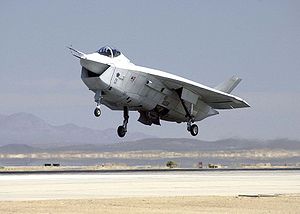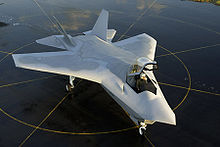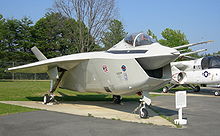Boeing X-32 Videos
|
Loading...
|
|
Boeing X-32
X-32 JSF

Picture - X-32
Role: Experimental fighter
Manufacturer: Boeing
First flight: 18 September 2000
Primary user: Defense Advanced Research Projects Agency (DARPA)
The Boeing X-32 was a multi-purpose jet fighter in the Joint Strike Fighter contest. It lost to the Lockheed Martin X-35 demonstrator which was further developed into the F-35 Lightning II.
Development
Background
In 1993, the Defense Advanced Research Projects Agency (DARPA) launched the Common Affordable Lightweight Fighter project (CALF). The project's purpose was to develop a stealth-enabled design to replace all of US DoD lighter weight fighter and attack aircraft, including the F-16 Fighting Falcon, F/A-18 Hornet, and vertical/short takeoff / vertical landing (V/STOL) AV-8B Harrier II. Around the same time the Joint Advanced Strike Technology (JAST) project was started. In 1994, the US Congress ordered the two to be merged into the Joint Strike Fighter Program.
Many companies took part in the first phase of this project, which involved drafting concept aircraft designs for submission to the Department of Defense. However on 16 November 1996, only Boeing and Lockheed Martin were awarded contracts, allowing them to produce two of their concept aircraft each. Under the contract, these fighters were required to demonstrate Conventional Take Off and Landing (CTOL), carrier take off and landing (CV version), and short take off and vertical landing (STOVL). They were also expected to include ground demonstrations of a production representative aircraft's systems, such as the Preferred Weapon System Concept (PWSC).
One major departure from previous projects was the prohibition of the companies from using their own money to finance development. Each was awarded $750 million to produce their two aircraft - including avionics, software and hardware. This limitation promoted the adoption of low cost manufacturing and assembly techniques, and also prevented either Boeing or Lockheed Martin from bankrupting themselves in an effort to win such an important contest.
Designing the X-32
The X-32 featured a large chin-mounted air intake akin to the F-8 Crusader and A-7 Corsair and a large one piece carbon fiber composite wing. The large intake did not contribute to the characteristically sleek look expected from a high-tech fighter. The wing was trapezoidal, spanning 9.15 meters, with a 55 degree leading edge sweep and could hold up to 20,000 pounds of fuel. The purpose of the high sweep angle was to allow for a thick wing section to be used while still providing limited transonic drag and to provide a good angle for wing-installed antenna equipment. The wing would prove a challenge to fabricate.
The engine is mounted directly behind the cockpit, which places it ahead of the center of gravity (a very rare thing for a jet fighter) and it also implies something special was added to the intake to prevent the blades from being directly visible to radar. Possibilities include a variable baffle designed to block incoming radar while not interfering with airflow.
Boeing had proposed in the 1960s a similarly aesthetically challenged supersonic fighter with a mid-center-of-gravity mounted engine with vectored thrust nozzles, but this never proceeded beyond pictures published in Aviation Week. By comparison, the Lockheed entry looked like, if anything, a smaller version of the F-22 Raptor stealth fighter.
Design changes
The two X-32 prototypes featured a delta wing design, which was chosen to minimize production manufacturing costs. However, eight months into construction of the prototypes, the JSF's maneuverability and payload requirements were refined at the request of the Navy and Boeing's delta wing design fell short of the new targets. Engineers put together a new design with a conventional tail (narrowly beating out a Pelikan tail) with reduced weight and improved agility, but it was too late to change the prototypes. It was judged that they would be sufficient to demonstrate Boeing's technology.
Flight testing
Due to the heavy delta wing design of the prototypes, Boeing demonstrated STOVL and supersonic flight in separate configurations, with the STOVL configuration requiring that some parts be removed from the fighter. The company promised that their conventional tail design for production models would not require separate configurations. By contrast, the Lockheed Martin X-35 prototypes were capable of transitioning between their STOVL and supersonic configurations in mid-flight.
The first flight of the X-32A (designed for CTOL and carrier trials) took place on 18 September 2000, from Boeing's Palmdale plant to Edwards Air Force Base. The X-32B demonstrated STOVL flight, first flying in March 2001. The X-32 achieved STOVL flight in much the same way as the AV-8B Harrier II with thrust vectoring of the jet and fan exhaust. The Lockheed Martin team used a riskier alternative, a shaft-driven lift fan powered by the main engine which was designed to generate more thrust than possible with only direct exhaust gases. A successful design would have greater payload, and thus longer range than a simple thrust vectored turbofan.
Flight testing of both companies' aircraft continued until July 2001.
JSF competition

Picture - Boeing's JSF production mockup. Note the separate wing and tailplanes.
On 26 October 2001, the Department of Defense announced that the Lockheed Martin X-35 won the JSF competition. One of the main reasons for this choice appears to have been the method of achieving STOVL flight, with the Department of Defense judging that the higher performance lift fan system was worth the extra risk. When near to the ground, the Boeing X-32 suffers from the problem of hot air from the exhaust circulating back to the main engine, which causes the thrust to weaken and the engine to overheat. The X-35 would be developed into the production F-35 Lightning II.
The loss of the JSF contract to Lockheed Martin in 2001 was a major blow to Boeing, as it represented the most important international fighter aircraft project since the Lightweight Fighter competition of the 1960s and 1970s, which had led to the F-16 Fighting Falcon and F/A-18 Hornet. The production run of the JSF was estimated at anywhere between 3,000 and 5,000. Prior to the awarding of the contract many lawmakers pushed the idea of retaining the losing competitor as a sub-contractor, however the "winner takes all" principle was not changed. Nonetheless Boeing views its work on the X-32 as a strategic investment, yielding important technologies which it has been able to adopt in the F/A-18E/F Super Hornet and other studies.

Picture - X-32B at Patuxent River Naval Air Museum.
In 2005 the Boeing X-32A was transferred to the National Museum of the United States Air Force in Dayton, Ohio. Its condition had deteriorated due to sitting outside for several years following the end of the JSF competition. The X-32B was transferred to the Naval Air Station Patuxent River's Naval Air Museum in St. Mary's County, Maryland in 2005. As of June 2009, it is undergoing restoration at the museum's restoration facility.
Specifications
General characteristics
Crew: 1
Length: 50.77 ft (15.47 m)
Wingspan: 36 ft (10.97 m)
Height: (5.28 m)
Wing area: 590 ft² (54.8 m²)
Max takeoff weight: 38,000 lb (17,200 kg)
Powerplant: 1x— Pratt & Whitney F135 afterburning turbofan
Dry thrust: 28,000 lbf (125 kN)
Thrust with afterburner: 43,000 lbf (191 kN)
Performance
Maximum speed: Mach 1.6 (1,200 mph, 1,931 km/h) at altitude
Range on USAF mission profile: 850 NM (1,575 km)
Range on United States Navy mission profile: 750 NM (1,390 km)
Range on USMC/RN mission profile: 594 NM (1,100 km)
Armament
20 mm M61A2 cannon, or 27 mm Mauser BK-27 cannon
Internal: 6 AMRAAM air-air missiles or 2 AMRAAM air-air missiles and 2 x 2,000 lb (900 kg) class guided bombs
External: Approx. 15,000 lb (6,800 kg) of full range of external stores including guided weapons, anti-radiation missile, air-to-surface weapons, auxiliary fuel tanks
Future Offensive Air System
Comparable aircraft
Lockheed Martin X-35
Mikoyan LMFS project 1.27
Bibliography
Keijsper, Gerald. Lockheed F-35 Joint Strike Fighter. London: Pen & Sword Aviation, 2007. ISBN 978-1-84415-631-3.
Boeing X-32 Pictures
Living Warbirds: The best warbirds DVD series.
Source: WikiPedia